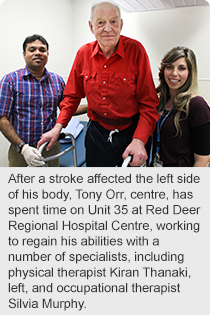
September 9, 2015
Story and photo by Heather Kipling
Returning to his beloved family home aside, there’s one place Tony Orr longs to return to – a place where he can cast a line in the hopes of outwitting a wily trout.
Fly fishing is a passion for Orr, one that he is working towards returning to with the help of a team of rehabilitation specialists at Red Deer Regional Hospital Centre (RDRHC). Orr has been a patient on Unit 35 – the rehabilitation unit – at RDRHC, recovering from both a stroke that paralyzed his left side, and a hard fall that left him with a broken hip. But the urge to fish is firmly intact.
“I want to go fishing,” says the Innisfail-area man. “That’s what I’d really like to get out and do.”
 And with the support of unit staff, stream banks and lakeshores aren’t as far away as they once seemed.
And with the support of unit staff, stream banks and lakeshores aren’t as far away as they once seemed.
“It’s very encouraging to see how far he has come,” says Orr’s wife, Christine. “When he was first admitted, he had very little use of his left arm or his hand, and he couldn’t stand or take five steps on his own.
“Now he can get himself up and out of bed. He can help feed himself and get dressed, and do many things for himself again. We couldn’t ask for better care.”
Established 11 years ago, Unit 35 is devoted to patient rehabilitation and helping patients like Orr get back to their routines.
Many patients have suffered a stroke, but the unit also cares for those who have had orthopedic or general surgeries, those recovering from accidents, and those with medical conditions requiring hospitalization which has altered their ability to function independently.
“Staff work together on the unit – and with staff from other areas – for the benefit of the patient,” says registered nurse Karen Nadon. “Patients are also active participants in their rehab. It’s like a job six days a week for patients, and that’s part of helping them reconnect with their life and get back to a daily routine.”
Part of that routine includes getting patients back into the habit of getting up and getting dressed before they begin working with staff.
“The goal is to work with patients to help them be as independent as possible, and the rehabilitation is very tailored to each individual to achieve the levels of function they had before – or more – whenever possible,” says physical therapist Kiran Thanaki.
Meeting patient goals requires involvement from all disciplines, including nursing staff, occupational therapists, physical therapists, speech-language pathologists, a physiatrist, recreation therapists, dietitians, pharmacists and a social worker, all of whom work on the unit.
And all help patients hone the skills they need for the job of living says occupational therapist Silvia Murphy.
“For example, if a patient is working on their balance with the physical therapists, we will employ a functional task such as cooking,” she says.
Orr has worked extensively with both Thanaki and Murphy during his time on the unit, as well as recreational therapist Hugh McKenna as part of regaining function and movement in his arm.
“It’s not about treating one aspect of a person’s well-being,” says McKenna. “You have to look at the cognitive, physical, social, emotional and spiritual aspects and take those into account. They all play a part in rehab.
“In Tony’s case, I’ve seen improvement in his entire demeanor. He’s much more spontaneous and he has a smile again.”
Orr agrees.
“I feel more like me now,” he says. “The staff have all been great supporters and I’m thankful for what they’ve done.”